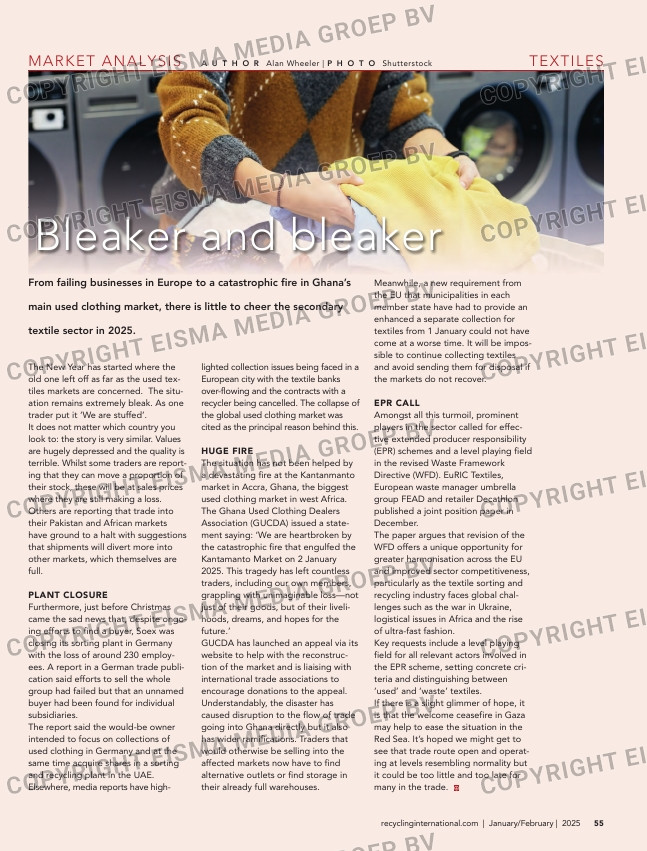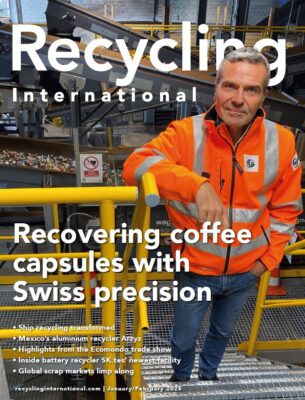Page 55 from: Recycling International Jan/Feb 2025

TEXTILESMARKET ANALYSIS
Bleaker and bleaker
From failing businesses in Europe to a catastrophic fire in Ghana’s
main used clothing market, there is little to cheer the secondary
textile sector in 2025.
55recyclinginternational.com | January/February | 2025
The New Year has started where the
old one left off as far as the used tex-
tiles markets are concerned. The situ-
ation remains extremely bleak. As one
trader put it ‘We are stuffed’.
It does not matter which country you
look to: the story is very similar. Values
are hugely depressed and the quality is
terrible. Whilst some traders are report-
ing that they can move a proportion of
their stock, these will be at sales prices
where they are still making a loss.
Others are reporting that trade into
their Pakistan and African markets
have ground to a halt with suggestions
that shipments will divert more into
other markets, which themselves are
full.
PLANT CLOSURE
Furthermore, just before Christmas
came the sad news that, despite ongo-
ing efforts to find a buyer, Soex was
closing its sorting plant in Germany
with the loss of around 230 employ-
ees. A report in a German trade publi-
cation said efforts to sell the whole
group had failed but that an unnamed
buyer had been found for individual
subsidiaries.
The report said the would-be owner
intended to focus on collections of
used clothing in Germany and at the
same time acquire shares in a sorting
and recycling plant in the UAE.
Elsewhere, media reports have high-
lighted collection issues being faced in a
European city with the textile banks
over-flowing and the contracts with a
recycler being cancelled. The collapse of
the global used clothing market was
cited as the principal reason behind this.
HUGE FIRE
The situation has not been helped by
a devastating fire at the Kantanmanto
market in Accra, Ghana, the biggest
used clothing market in west Africa.
The Ghana Used Clothing Dealers
Association (GUCDA) issued a state-
ment saying: ‘We are heartbroken by
the catastrophic fire that engulfed the
Kantamanto Market on 2 January
2025. This tragedy has left countless
traders, including our own members,
grappling with unimaginable loss—not
just of their goods, but of their liveli-
hoods, dreams, and hopes for the
future.’
GUCDA has launched an appeal via its
website to help with the reconstruc-
tion of the market and is liaising with
international trade associations to
encourage donations to the appeal.
Understandably, the disaster has
caused disruption to the flow of trade
going into Ghana directly but it also
has wider ramifications. Traders that
would otherwise be selling into the
affected markets now have to find
alternative outlets or find storage in
their already full warehouses.
Meanwhile, a new requirement from
the EU that municipalities in each
member state have had to provide an
enhanced a separate collection for
textiles from 1 January could not have
come at a worse time. It will be impos-
sible to continue collecting textiles
and avoid sending them for disposal if
the markets do not recover.
EPR CALL
Amongst all this turmoil, prominent
players in the sector called for effec-
tive extended producer responsibility
(EPR) schemes and a level playing field
in the revised Waste Framework
Directive (WFD). EuRIC Textiles,
European waste manager umbrella
group FEAD and retailer Decathlon
published a joint position paper in
December.
The paper argues that revision of the
WFD offers a unique opportunity for
greater harmonisation across the EU
and improved sector competitiveness,
particularly as the textile sorting and
recycling industry faces global chal-
lenges such as the war in Ukraine,
logistical issues in Africa and the rise
of ultra-fast fashion.
Key requests include a level playing
field for all relevant actors involved in
the EPR scheme, setting concrete cri-
teria and distinguishing between
‘used’ and ‘waste’ textiles.
If there is a slight glimmer of hope, it
is that the welcome ceasefire in Gaza
may help to ease the situation in the
Red Sea. It’s hoped we might get to
see that trade route open and operat-
ing at levels resembling normality but
it could be too little and too late for
many in the trade.
A U T H O R Alan Wheeler | P H O T O Shutterstock
55_matextiles.indd 55 29-01-2025 11:33



